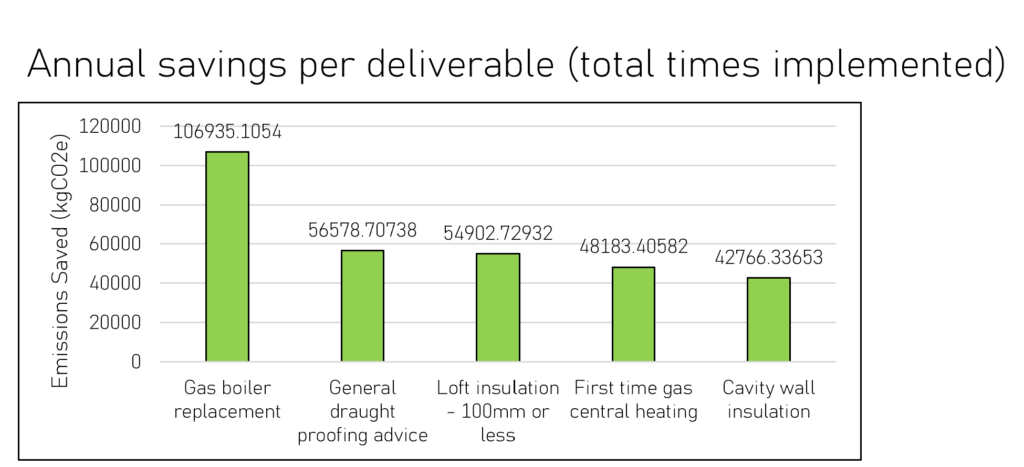A University of Exeter researcher has found that Exeter Community Energy (ECOE)’s fuel poverty work prevents seven times the amount of carbon dioxide emissions that its solar installations do. Joe Francis, a global sustainability master’s degree student, found that ECOE’s Healthy Homes for Wellbeing project prevented 595 tonnes of emissions from February 2021-March 2022. That came from helping 4,411 homes in fuel poverty, saving clients an estimated £1.72 million.
Over the same period ECOE’s ten rooftop photovoltaic installations, with 484kW peak output, generated 377MWh of electricity. That’s equivalent to the electricity consumed by about 121 homes. That prevented 83.5 tonnes of carbon dioxide emissions, which would otherwise have driven climate change by trapping heat in Earth’s atmosphere.
‘I looked at each low energy deliverable that was implemented within a one-year period,’ Joe explains. ‘That saved around 600,000 kilogrammes of carbon dioxide equivalent emissions. And in the same period, ECOE used about 10,000 kilogrammes of carbon dioxide equivalent emissions. So overall, there’s a massive amount of savings and a tiny amount of emissions produced.’
Joe worked this out starting from Industry Saving Values (ISVs) that the Energy Savings Trust (EST) painstakingly collects for many different things you can do to save electricity or gas. The EST has figures for 77 out of the 83 energy-saving steps, or ‘deliverables’ as Joe calls them, that Healthy Homes offers. The ISV estimates the amount of money each deliverable saves the home they happen in.
Bigger measures, bigger impact

These energy-saving “deliverables” contributed most to the reduction in carbon emissions resulting from the Healthy Homes for Wellbeing project. Credit: Joe Francis
To work out how much energy each deliverable saved, Joe divided the money saved by the cost of electricity or gas, depending on which of these they applied to. That gave him numbers of units of electricity or gas that each deliverable prevented. He could then multiply these figures by ‘greenhouse gas conversion factors’ provided by the UK’s Department of Business, Energy and Industrial Strategy. That provided estimates for the emissions each deliverable prevented. Large-scale measures, either installing or replacing gas boilers or installing insulation, produced the most significant savings.
Then, Joe worked out how often Healthy Homes for Wellbeing provided each deliverable to a home in the financial year. He then multiplied that number by the emissions prevented each time. Finally, he added up the total savings, finding that it was equivalent to 605 tonnes of carbon dioxide. The most significant savings were produced by large-scale measures, either installing or replacing gas boilers or installing insulation. For example, ECOE replaced gas boilers 91 times in the period Joe studied, which saved 107 tonnes of carbon dioxide. It installed cavity wall insulation 74 times, which prevented 43 tonnes of carbon dioxide emissions.
Next, Joe worked out how much carbon dioxide ECOE was directly responsible for emitting. To do this, he estimated how much electricity and petrol the Healthy Homes team consumed. Multiplying those figures by greenhouse gas conversion factors found that they produced 10 tonnes of carbon dioxide. Overall, the fuel poverty work prevented 595 tonnes of carbon dioxide being emitted.
Useful, if not specific
The estimate provides ‘a good general idea of carbon savings that the Healthy Homes for Wellbeing project has produced’, says Joe. However, he warns that figures such as greenhouse gas conversion factors, ISVs and energy prices are assumptions. ‘They only provide a very general value,’ Joe explains. ‘In order to be any more specific, you have to look at each deliverable, at each individual household. It would take too much time and too much resource.’
The estimates could help guide decisions more broadly about how best to save energy and fight climate change though, Joe continues. They also help ECOE judge how effective its activities are, and as such Joe will repeat the assessment next year.
For more information you can read a presentation from Joe about his work here.


